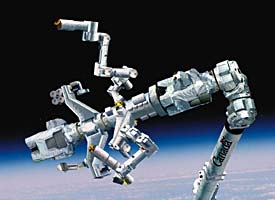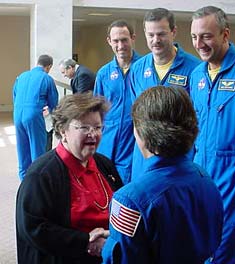
The Special Purpose Dexterous Manipulator (SPDM) is a two-armed robot designed to carry out delicate assembly and servicing tasks on the International Space Station that would otherwise have to be done by space-walking astronauts. Something like SPDM may also prove useful in servicing the Hubble Space Telescope.
Courtesy MD Robotics, a MacDonald Dettwiler Company.
While astronomers and politicians continue to debate NASA's decision to cancel further shuttle missions to the Hubble Space Telescope, engineers are looking for other ways to keep the orbiting observatory alive as long as possible. Already they're changing how they operate the telescope to circumvent or delay inevitable hardware failures. And they're looking at the possibility of dispatching an advanced robot to perform some, if not all, of the servicing tasks that were originally to be carried out by space-walking astronauts.
Left alone, Hubble will die of progressive equipment breakdowns. Its two most critical systems are its gyroscopes, which help point the telescope at specific targets, and its batteries, which provide power to keep the spacecraft's electronics warm during orbital night. Normal operations require three gyros, one for each axis. Of the six new gyros installed during a 1999 shuttle servicing mission, four still work. NASA estimates that two more could fail by the middle of next year, at which point scientific observations would cease. Michael R. Moore (NASA Headquarters) says that flight controllers are busy developing software to aim the telescope with only two gyros, as has been done successfully with several other satellites, and they expect to have it ready before it's needed. But that would buy astronomers at most a year or so until a fifth gyro fails sometime in 2006 or 2007.
Even when Hubble can no longer be aimed at will, it could still have some life left in it — but only until its batteries wear out. The telescope still has its original nickel-hydrogen cells, installed before launch in 1990. Their capacity to recharge has diminished over the years, and fresh batteries were to be installed during the next shuttle visit. Without them the spacecraft's power level will fall too low to keep the onboard computer alive, probably around 2008 according to Moore. He adds that observatory operators are experimenting with new approaches to charging the batteries to try to extend their useful life, "so 2008 could be a conservative estimate."

Senator Barbara Mikulski (D-Maryland), a staunch defender of the Hubble Space Telescope, greets crew members of the last Hubble servicing mission in 2002.
Courtesy the Office of Sen. Barbara Mikulski.
It might seem pointless to worry about Hubble's state of health once it can no longer capture celestial images and spectra, but it's not. That's because NASA administrator Sean O'Keefe's mid-January decision to cancel future Hubble servicing missions is under review by the National Academy of Sciences and the General Accounting Office. Senators Christopher "Kit" Bond (R-Missouri) and Barbara Mikulski (D-Maryland), chair and ranking minority member, respectively, of the Senate subcommittee that holds the space agency's purse strings, demanded the reviews in mid-March; the studies should be completed this summer. Mikulski and Sam Brownback (R-Kansas) have also introduced a resolution in the Senate identical to one submitted to the House of Representatives by Congressman Mark Udall (D-Colorado) in early March. Both resolutions call on NASA to continue preparations for the next Hubble servicing mission while the reviews are under way.
Whatever the independent studies conclude, O'Keefe has gone on record saying he will not risk astronauts' lives by sending them to Hubble, which offers no safe haven should their shuttle be damaged at liftoff, unlike flights to the International Space Station (ISS) — the winged space plane's only remaining destination. O'Keefe has directed the Hubble team to consider robotic options for servicing the telescope instead.
In response to a recent call for ideas from the aerospace industry, NASA received nearly two dozen proposals. One would use something like the Special Purpose Dexterous Manipulator (SPDM), a two-armed robot already built for use on the ISS. Remotely controlled by an operator on the ground, the ultrasensitive SPDM might be able to attach new gyros and batteries, enabling science operations to continue well into the next decade. That would be welcome news for astronomers, who want to keep using Hubble in parallel with the Chandra X-ray Observatory and the infrared Spitzer Space Telescope, both of which are expected to last until 2010 or beyond — and because NASA's next major observatory, the James Webb Space Telescope, won't be launched until 2011 at the earliest.
It remains unclear whether a robot could also upgrade Hubble's scientific capabilities. Two new instruments, the Cosmic Origins Spectrograph and the Wide Field Camera 3, have already been built at a cost of nearly $200 million. They would have to be placed deep inside the telescope after the removal of existing instruments, something considerably more difficult and risky than simply bolting new equipment to the outside of the observatory and connecting a few cables, as could be done for the gyros and batteries.
Of course, there's no guarantee that a robotic servicing mission will be funded, even if one is deemed technically feasible. The latest NASA budget doesn't include money for any more Hubble repairs, though it does provide $300 million for a robotic mission to attach a retrorocket to the telescope before it burns up in the atmosphere early in the next decade. The booster would steer Hubble harmlessly into the ocean, avoiding the danger of an uncontrolled reentry that might spread debris over populated areas. Expanding the scope of this robotic rescue might require NASA to take money from other space-science missions. Or Congress could decide to increase NASA's budget to cover the extra expense. Either way, it's clear that the final chapter in the ongoing Hubble saga is yet to be written.
 0
0
Comments
You must be logged in to post a comment.